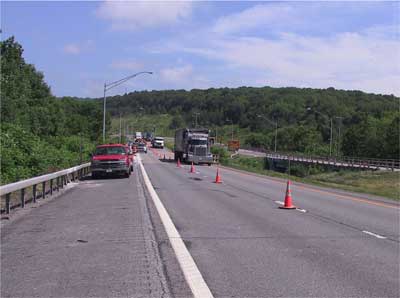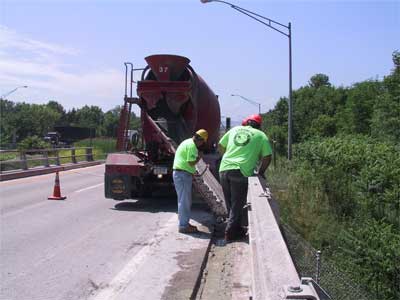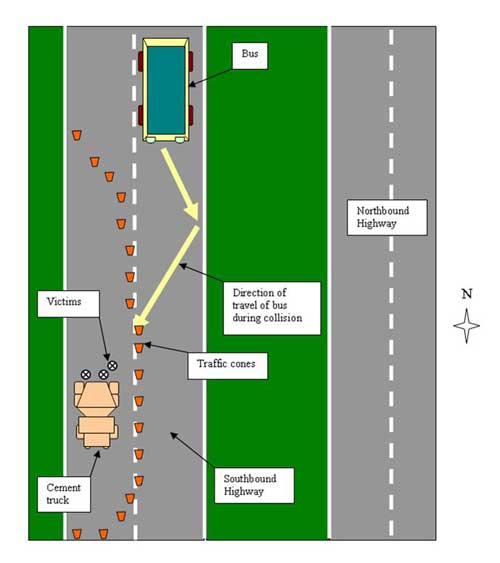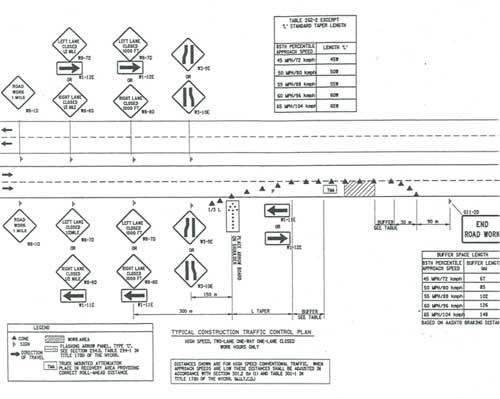Three Construction Workers Killed after being Struck by a Bus in a Highway Work Zone
New York Case Report 05NY039
Summary
On May 20, 2005, three male construction workers, employed by a paving company, sustained fatal injuries when they were struck by a passenger bus in a highway work zone. The work zone, located in the southbound lane of a four-lane divided interstate highway, was demarcated by the required orange traffic cones and warning signs. The southbound driving lane was closed and the passing lane was open to traffic. At approximately 10:00 a.m., a southbound charter bus passed multiple warning signs as it approached the work zone. The bus driver attempted to brake approximately 0.2 miles south of the beginning of the work zone and move left, partially onto the median’s shoulder, in an attempt to avoid striking the slowing vehicles ahead. Unable to move to the shoulder, the bus struck a motorcycle, hit the curb on the east side of the bridge, returned to the southbound passing lane and struck the rear of a tractor-trailer. The bus entered the work zone and struck the three victims who were working at the rear of a cement truck. After hitting the victims, the bus struck the cement truck in the rear bumper. The bus and the cement truck traveled together for 51 to 58 feet and collided with a parked, unoccupied pick-up truck. Immediately following the incident, the site supervisor called 911 to summon emergency medical services (EMS) who arrived at the site within minutes. One victim was pronounced dead at the scene. The other two victims were transported to a hospital where they both died. Two cement company employees and a NYSDOT inspector suffered minor injuries while escaping the collision. They were treated and released. The motorcyclist and six bus passengers were treated for injuries at a local hospital. The bus driver sustained critical injuries, was hospitalized, and later recovered.
New York State Fatality Assessment and Control Evaluation (NY FACE) investigators concluded that to help prevent similar incidents from occurring in the future, bus companies should:
- Inspect buses more frequently to insure that all parts and accessories function properly; and
- Provide frequent training to bus drivers regarding highway work zone safety issues.
Transportation administrative agencies that are responsible for designing traffic control plans on interstate highways and bridges should consider requiring:
- Use of protective barriers to shield workers from intruding vehicles;
- Use of portable rumble strips/speed bumps on roadways to warn motorists of highway construction work zones;
- Reduced speed limits through work zones on highways with high traffic volume to protect workers; and
- Use of law enforcement officers in cruisers with flashing lights at the entrance to a highway work zone, and an additional law enforcement vehicle at the end of the work zone to enforce speed limits.
Introduction
On May 20, 2005, three male construction workers who were employed by a paving company sustained fatal injuries when they were struck by a passenger bus inside a highway work zone. NY FACE staff learned of the incident on May 23 from newspaper articles. On June 28, 2005 a NY FACE investigator traveled to the incident site to observe the work zone set-up and work activities and to collect information surrounding the fatal incident. The regional office of the New York State Department of Transportation (NYSDOT) provided assistance during the course of the FACE investigation. The case was reviewed with the compliance officer of the Occupational Safety and Health Administration (OSHA) who investigated the incident. The New York State Police incident report and collision reconstruction report, Medical Examiner’s reports, and death certificates were reviewed. The NYSDOT accident review board also conducted an investigation.
The victims’ employer has been in the highway construction and maintenance business for 60 years and employs approximately 200 unionized workers. The company had developed safety and health programs required by OSHA and provided employees with annual safety training. A “Tool Box Talk” was held monthly to discuss safety issues with the employees. Workers were required to wear high visibility orange vests or T-shirts, hard hats, safety glasses, gloves, and steel-toed boots when working on highway projects.
Two of the victims had been employed with the company for five years and one victim was employed for six years. This was the company’s first fatal incident.
The bus driver of the passenger bus was employed by a charter bus company in Missouri. According to the New York State Police, the driver held a Valid Class B license and had not been cited for any violations prior to the fatal incident. The Missouri State Department of Transportation (MoDOT) inspected the bus company 65 times during the last two years and did not find any substantial safety violations. The charter bus company declined to provide information relating to the incident.
Back to Top
Investigation
At the time of the incident, the paving company had been contracted by NYSDOT for a highway bridge repair/maintenance job on eight bridges on a major divided state highway. The project included dismantling the existing bridge curbs and pouring concrete to form new curbs. The paving company was the general contractor for the project. There were two sub-contractors involved in the project: a cement company that delivered cement to the site and a concrete sawing company that dismantled the existing bridge curbs. The project started in May, 2005 and was expected to last for three months.
The section of the interstate highway where the fatal incident occurred was a four-lane divided highway for travel in a north/south direction. A grassy median divided the two southbound and two northbound travel lanes (Figure 1, pg. 9). The width of the southbound driving lane was approximately 11.6 feet and the width of the passing lane was 10.6 feet. The bridge shoulder on the east side was approximately 2.5 feet wide and the west side shoulder was approximately 4.3 feet wide. The regular speed limit in this section of the highway was 65 miles per hour (mph). At the time of the fatal incident, there were construction work zones on both the northbound and southbound lanes and the victims were working in the southbound lanes.
The temporary traffic control plan (Figure 2) was designed by NYSDOT based on the Federal Highway Administration’s Manual on Uniform Traffic Control Devices (MUTCD). The speed limit was reduced to 55 mph within the temporary traffic control zone. The southbound driving lane was closed and the passing lane was open to traffic (Photo 1). According to the state police collision reconstruction report, signs reading “Construction Ahead”, “Right Lane Closed”, “Reduced Speed Ahead” and “55 MPH Speed Zone” as well as an electronic arrow board were placed along the 1.5 miles north of the construction zone to warn travelling motorists. The arrow board had an illuminated arrow pointing to the left (east) towards the passing lane, indicating that the driving lane was closed and motorists should merge into the passing lane. The work zone was demarcated by orange traffic cones starting approximately 0.2 miles north of the collision scene. The warning signs and orange traffic cones were set up by the paving company and inspected by NYSDOT inspectors. According to the NYSDOT representative, all traffic control devices were set up correctly.
The fatal incident occurred on May 20, two weeks after the project started. At the time of the incident, twelve paving company employees, two cement company employees, two employees from the cement cutting company, and two NYSDOT inspectors were on site. Prior to the incident, a cement truck, parked on the southbound bridge, was preparing to pour cement into bridge curb molds. The three victims were working at the back (north) of the cement truck in a position similar to the workers shown in Photo 2 that was taken after the fatal incident. A NYSDOT inspector and two cement company employees were in front of the cement truck at the time of the incident.

|
 |
|
Photo 2. Paving company employees working at the rear end of the cement truck. (Photo was taken the day after work resumed, one month after the fatal incident. The cement truck and the workers pictured are in the same position as the victims at the time of the fatal incident.)
|
At approximately 10:00 a.m., the southbound charter bus, carrying a choral group, passed multiple warning signs and approached the work zone. The bus was a 1996 VanHool that was approximately 43 feet long and weighed 39,000 to 44,000 pounds. At approximately 0.2 miles south of the beginning of the construction zone, the bus driver attempted to brake and move left, partially onto the east shoulder, in an attempt to avoid striking the slowing vehicles ahead. According to the State Police collision reconstruction report, the bus first struck a motorcycle and then hit the curb on the east side of the bridge before returning to the southbound passing lane and striking the rear of a tractor-trailer. The bus was redirected in a southwest direction into the work zone, striking three victims who were working at the back of a cement truck. The bus then struck the cement truck in the rear bumper. Pushing the cement truck, the bus traveled approximately 51 to 58 feet and stopped while it was still in contact with the rear of the cement truck. The collision with the bus caused the cement truck to be pushed into a pick up truck that was parked in front of it. The NYSDOT inspector and two cement company employees were able to escape the collision with minor injuries.
Immediately following the incident, the site supervisor called 911 to summon emergency medical services (EMS). EMS arrived at the site within minutes. One victim was pronounced dead at the scene. The other two were transported to a hospital where they both died. The motorcyclist, NYSDOT inspector, and two cement company employees were treated for injuries and released. Six bus passengers were treated for lacerations at a local hospital. The bus driver sustained critical injuries; he was hospitalized and later recovered.
The day after the fatal incident, NYSDOT’s Passenger and Freight Safety Division (PFSD) performed a mechanical inspection of the bus. The inspection found several defects existed prior to the collision in the bus’ brake system such as “no brake application” on the Rear Axle 2, “all brakes at or beyond readjustment limit” on Rear Axle 1 and missing return springs and right rear rivets on Rear Axle 2. The PFSD concluded that based on the defects detected, the bus had a braking capacity of approximately 30-35% at the time of the collision. The New York State Police Collision Reconstruction Unit calculated the vehicle speeds at the time of the collision and determined that the bus was traveling in a range of 60 to 68 mph when it struck the tractor-trailer. It could be reasonably assumed that the bus was traveling faster prior to its initial collision with the motorcycle. The State Police determined that the primary cause of the collision was inadequate brakes and the secondary contributing causative factor was speeding within the work zone.
The NYSDOT suspended the construction operation immediately following the incident. The temporary traffic control plan was reviewed and revisions were made. Under the revised plan, the State Police Traffic Units sent trooper cars to patrol the work zone and enforce the traffic control. The NYSDOT also further reduced the speed limit within the work zone to 45 mph and the State Police increased the fine associated with speeding violations. On June 28, the first day when work resumed following the fatal incident, the troopers issued 40 speeding tickets at the incident site, according to the State Police.
In response to the fatal incident, the New York State legislature passed the Work Zone Safety Act of 2005 that is designed to enhance driver education, increase the accountability of drivers, and create safer highway work zones. The key provisions of the Act include increased police presence in work zones, increased deployment of radar speed-display signs in work zones, increased monetary fines, and a 60-day suspension of driver’s licenses for repeated work zone speeding violations.
Back to Top
Cause of Death
The causes of death for the three victims were listed on the death certificates as follows: two of the victims died of shock as a result of multiple internal trauma; the third victim died of exsanguination due to transection at the level of the pelvis.
Back to Top
Recommendations/Discussion
Recommendation #1: Bus companies should inspect buses more frequently to insure that all parts and accessories function properly.
Discussion: The Federal Motor Carrier Safety Administration (FMCSA) requires that all commercial motor vehicle carriers perform at least annual inspections on their vehicles. Charter buses are usually driven more extensively and therefore should be inspected more frequently, e.g. once every six months to ensure that all parts and accessories function properly and to identify mechanical or electrical problems early. Bus companies should also require their drivers to perform pre-trip, enroute, and post-trip inspections. Drivers should document the results of the vehicle inspections and report mechanical problems immediately to the bus companies. Buses should not be returned to service until all problems are fixed.
Recommendation #2: Bus companies should provide frequent training to their drivers regarding highway work zone safety issues.
Discussion: Charter bus companies should provide frequent training to their drivers regarding highway work zone safety issues, such as standard signage, protective apparel colors, and the importance of obeying postings to shift/merge lanes and reducing speed when approaching a work zone. The training should be part of regular driver education courses by employers and should be included in company driver training manuals.
Recommendation #3: Transportation administrative agencies responsible for designing traffic control plans should consider requiring the use of protective barriers to shield workers from intruding vehicles.
Discussion: The work zone in this incident was set up following MUTCD guidelines. The work crew used standard safety practices and precautions. Even with these standard precautions in place, the bus entered the work zone without appearing to have responded to the warning signs and traffic cones. Cones and other delineating devices can be useful in defining the proper traffic lanes for the work zone, but they provide no physical protection from intruding vehicles.
Protective barriers, such as concrete barricades, sometimes referred to as Jersey barriers or water-ballasted barriers can prevent injury and death. These types of barriers require additional planning and set-up time and employers need to have the right equipment available to place and remove the barriers.
Recommendation #4: Transportation administrative agencies should consider requiring the use of portable rumble strips/speed bumps on roadways to warn motorists of highway construction work zones.
Discussion: In order to enhance the ability of drivers to recognize the need to slow down for work zones, transportation administrative agencies should consider requiring the use of portable rumble strips/speed bumps on roadways to warn motorists of highway work zones. There are a variety of products on the market that can provide not only visual information for a driver to slow down but also audible and tactile input. Use of these types of warning devices requires additional planning and set-up time; however, they can be well worth the time, effort and cost because of their life-saving potential.
Recommendation #5: Transportation administrative agencies should consider requiring reduced speed limits through work zones on highways with high traffic volume to protect workers.
Discussion: Highway construction work zones are hazardous areas where workers are extremely vulnerable to speeding vehicles. Speeds within highway work zones should be reduced so that traffic can continue to flow while giving both motorists and workers the longest time to react when responding to danger, thereby enhancing workers’ safety in highway work zones. In this case, the speed limit was reduced to 45 mph through the work zone after the fatal incident.
Recommendation #6: Transportation administrative agencies should consider requiring the use of law enforcement officers in cruisers at each end of large highway work zones.
Discussion:Law enforcement vehicles are one of the most effective visual warning methods used at highway work zones.Motorists may be more likely to recognize law enforcement authorities and slow down as the result of their presence. If resources are available, it may be beneficial to have a police vehicle stationed strategically near the beginning of the work zone as a warning device, along with a second police vehicle patrolling the work zone and ticketing speeders and other violators. The New York State Work Zone Safety Act of 2005 recognizes this and recommends police presence in highway work zones.
Keywords: highway work zone, construction, motor vehicle accident, struck by
References
-
US Department of Transportation/Federal Highway Administration. Manual on Uniform Traffic Control Devices (MUTCD). Retrieved October 5, 2006 from http://mutcd.fhwa.dot.gov/external icon
- US Department of Transportation/Federal Motor Carrier Safety Administration. 49 CFR 383 Commercial Driver’s License Standards; Requirements and Penalties. Retrieved October 5, 2006 from http://www.fmcsa.dot.gov/external icon
- New York State Assembly. New York State Work Zone Safety Act of 2005. Retrieved October 5, 2006 from http://assembly.state.ny.us/leg/?bn=S04885&sh=t (Link No Longer Available 11/15/2011)
- CDC/NIOSH. Building Safety Highway Work Zones: Measures to Prevent Worker Injuries from Vehicles and Equipment. DHHS/NIOSH Pub. No. 2001-128. Retrieved October 5, 2006.
- CDC/NIOSH. NIOSH FACE in-house Report # 2000-02: Flagger Struck from Behind and Killed by a Truck Intruding into a Highway Construction Work Zone-Wisconsin. Retrieved October 5, 2006.
- Washington State Department of Labor and Industries. WA FACE Program/Sharp report #52-10-2003: Lineman Killed after being Struck by a Car in Washington State. Retrieved October 5, 2006 from http://www.lni.wa.gov/Safety/Research/FACE/files/pud.pdfpdf iconexternal icon
New York FACE Program
The Fatality Assessment and Control (FACE) program is one of many workplace health and safety programs administered by the New York State Department of Health (NYS DOH). It is a research program designed to identify and study fatal occupational injuries. Under a cooperative agreement with the National Institute for Occupational Safety and Health (NIOSH), the NYS DOH FACE program collects information on occupational fatalities in New York State (excluding New York City) and targets specific types of fatalities for evaluation. NYS FACE investigators evaluate information from multiple sources. Findings are summarized in narrative reports that include recommendations for preventing similar events in the future. These recommendations are distributed to employers, workers, and other organizations interested in promoting workplace safety. The FACE program does not determine fault or legal liability associated with a fatal incident. Names of employers, victims and/or witnesses are not included in written investigative reports or other databases to protect the confidentiality of those who voluntarily participate in the program.
Additional information regarding the New York State FACE program can be obtained from:
New York State Department of Health FACE Program
Bureau of Occupational Health
Flanigan Square, Room 230
547 River Street
Troy, NY 12180
1-866-807-2130
http://www.health.ny.gov/environmental/investigations/face/external icon (Link updated 4/8/2013)
Figures
 |
 |
|
Figure 2. Construction traffic control plan.
|
